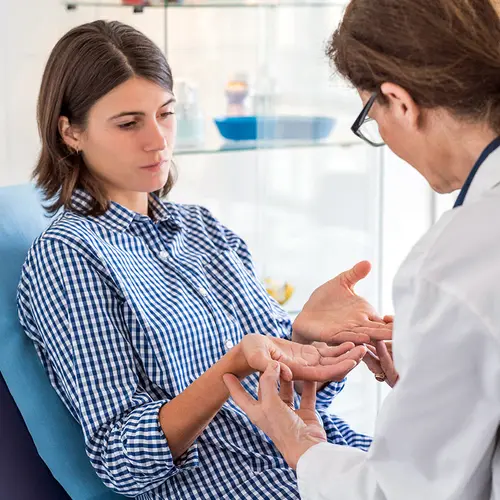Psoriatic arthritis is an autoimmune condition that causes joint problems alongside psoriasis. It can affect just about any joint in your body, including your knees. There is no cure, but there are treatments to help manage pain and limit or slow down damage to your knee. Here’s what you need to know.
What Causes Psoriatic Arthritis?
Researchers don’t know what causes psoriatic arthritis, but they do know that it’s an autoimmune disease. In this case, your body’s immune system starts to attack healthy tissues in your knee and other joints.
Not everyone with psoriasis gets psoriatic arthritis. But experts think it may be genetic because up to 40% of people with psoriatic arthritis have a family member with the condition. An infection may trigger psoriatic arthritis if it already runs in your family.
You could be at increased risk of arthritis affecting your knee if you:
- Put a lot of stress on your knees (from high-impact sports, for example)
- Are overweight
- Have had knee injuries
Mild psoriatic arthritis can be oligoarticular and only affect one to four joints. But it most commonly affects five or more joints and is called polyarticular.
What Are the Symptoms of Psoriatic Arthritis in the Knee?
The most commonly recognized symptom of knee psoriatic arthritis is pain. For some, the pain comes on gradually, but it can be sudden and severe in others. Most people with psoriatic arthritis switch between periods of relief (called remission) and flares, which become more frequent and longer. Other symptoms include:
Stiffness in the knee. This happens most often if you’ve been sitting for long periods or sleeping. It can be caused by inflammation (swelling) in the knee that increases when you aren’t moving the joint.
Reduced range of motion in the knee. Caused by the pain or by damage to the joint.
Popping or snapping sounds. Or a crackling feeling called crepitus coming from the knee when you move it.
Knee buckling. This is when your knee gives way while standing or walking.
You may also have symptoms not related to your knee, such as:
- Psoriasis plaques on the skin, usually looking silver or gray, with scales or rough spots
- Papules, small raised areas of skin
- Pitting and lifting fingernails or toenails (nail psoriasis)
- Fatigue
- Anemia
Interestingly, nail psoriasis is considered a sign of psoriatic arthritis.
How Is Psoriatic Arthritis of the Knee Diagnosed?
Unlike some diseases, such as diabetes and high blood pressure, there aren’t any tests to say that you specifically have psoriatic arthritis in your knee. Doctors make the diagnosis based on what they learn from your medical history and tests that rule out other illnesses, like rheumatoid arthritis.
Your doctor will want to know:
- When your symptoms started
- The type of pain you feel
- How long the pain lasts
- If anything makes the pain worse
- If you have a diagnosis of psoriasis
- If anyone in your family has psoriasis or psoriatic arthritis, or any other autoimmune disease
During a physical exam, your doctor will check your knee for:
- Swelling
- Range of motion
- Warmth (warmer than the skin around the knee)
Some tests can also point to a diagnosis of psoriatic arthritis in your knee. They include:
- X-rays
- Blood tests to check for signs of inflammation in your body and to rule out rheumatoid arthritis
- Tests of fluid taken from your knee, if necessary
If you don’t have psoriasis plaques on your skin but your doctor believes you have psoriatic arthritis in your knee, you may be sent to a dermatologist for further testing. Although not common, some people only learn they have psoriasis when they develop arthritis.
How Is Psoriatic Arthritis in the Knee Treated?
Medications that may help reduce inflammation and manage pain include:
- Nonsteroidal anti-inflammatory drugs (NSAIDs) like ibuprofen and naproxen
- Corticosteroids such as prednisone
- Disease-modifying antirheumatic drugs (DMARDs)
Other treatments include a knee replacement, physical therapy, and braces or other assistive devices. If movement causes pain, it’s understandable to want to keep still. But some exercise may be helpful to keep your knee pain from worsening. Doctors also advise people who are overweight or obese to lose weight to lessen the impact on the knee. Ask your doctor what’s best for you.

